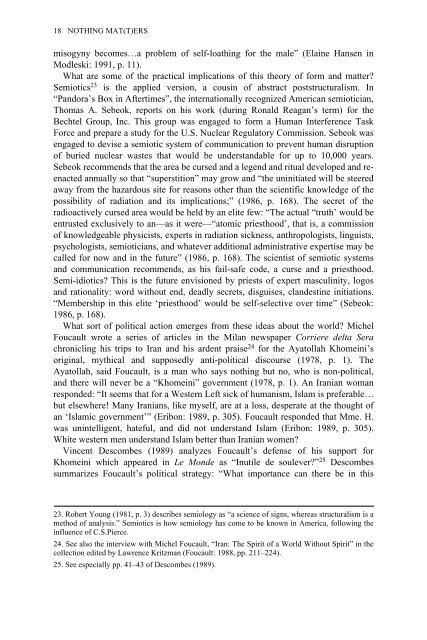Nothing Mat(t)ers: A Feminist Critique of Postmodernism
Nothing Mat(t)ers: A Feminist Critique of Postmodernism
Nothing Mat(t)ers: A Feminist Critique of Postmodernism
You also want an ePaper? Increase the reach of your titles
YUMPU automatically turns print PDFs into web optimized ePapers that Google loves.
18 NOTHING MAT(T)ERS<br />
misogyny becomes…a problem <strong>of</strong> self-loathing for the male” (Elaine Hansen in<br />
Modleski: 1991, p. 11).<br />
What are some <strong>of</strong> the practical implications <strong>of</strong> this theory <strong>of</strong> form and matter<br />
Semiotics 23 is the applied v<strong>ers</strong>ion, a cousin <strong>of</strong> abstract poststructuralism. In<br />
“Pandora’s Box in Aftertimes”, the internationally recognized American semiotician,<br />
Thomas A. Sebeok, reports on his work (during Ronald Reagan’s term) for the<br />
Bechtel Group, Inc. This group was engaged to form a Human Interference Task<br />
Force and prepare a study for the U.S. Nuclear Regulatory Commission. Sebeok was<br />
engaged to devise a semiotic system <strong>of</strong> communication to prevent human disruption<br />
<strong>of</strong> buried nuclear wastes that would be und<strong>ers</strong>tandable for up to 10,000 years.<br />
Sebeok recommends that the area be cursed and a legend and ritual developed and reenacted<br />
annually so that “sup<strong>ers</strong>tition” may grow and “the uninitiated will be steered<br />
away from the hazardous site for reasons other than the scientific knowledge <strong>of</strong> the<br />
possibility <strong>of</strong> radiation and its implications;” (1986, p. 168). The secret <strong>of</strong> the<br />
radioactively cursed area would be held by an elite few: “The actual “truth’ would be<br />
entrusted exclusively to an—as it were—“atomic priesthood’, that is, a commission<br />
<strong>of</strong> knowledgeable physicists, experts in radiation sickness, anthropologists, linguists,<br />
psychologists, semioticians, and whatever additional administrative expertise may be<br />
called for now and in the future” (1986, p. 168). The scientist <strong>of</strong> semiotic systems<br />
and communication recommends, as his fail-safe code, a curse and a priesthood.<br />
Semi-idiotics This is the future envisioned by priests <strong>of</strong> expert masculinity, logos<br />
and rationality: word without end, deadly secrets, disguises, clandestine initiations.<br />
“Memb<strong>ers</strong>hip in this elite ‘priesthood’ would be self-selective over time” (Sebeok:<br />
1986, p. 168).<br />
What sort <strong>of</strong> political action emerges from these ideas about the world Michel<br />
Foucault wrote a series <strong>of</strong> articles in the Milan newspaper Corriere delta Sera<br />
chronicling his trips to Iran and his ardent praise 24 for the Ayatollah Khomeini’s<br />
original, mythical and supposedly anti-political discourse (1978, p. 1). The<br />
Ayatollah, said Foucault, is a man who says nothing but no, who is non-political,<br />
and there will never be a “Khomeini” government (1978, p. 1). An Iranian woman<br />
responded: “It seems that for a Western Left sick <strong>of</strong> humanism, Islam is preferable…<br />
but elsewhere! Many Iranians, like myself, are at a loss, desperate at the thought <strong>of</strong><br />
an ‘Islamic government’” (Eribon: 1989, p. 305). Foucault responded that Mme. H.<br />
was unintelligent, hateful, and did not und<strong>ers</strong>tand Islam (Eribon: 1989, p. 305).<br />
White western men und<strong>ers</strong>tand Islam better than Iranian women<br />
Vincent Descombes (1989) analyzes Foucault’s defense <strong>of</strong> his support for<br />
Khomeini which appeared in Le Monde as “Inutile de soulever” 25 Descombes<br />
summarizes Foucault’s political strategy: “What importance can there be in this<br />
23. Robert Young (1981, p. 3) describes semiology as “a science <strong>of</strong> signs, whereas structuralism is a<br />
method <strong>of</strong> analysis.” Semiotics is how semiology has come to be known in America, following the<br />
influence <strong>of</strong> C.S.Pierce.<br />
24. See also the interview with Michel Foucault, “Iran: The Spirit <strong>of</strong> a World Without Spirit” in the<br />
collection edited by Lawrence Kritzman (Foucault: 1988, pp. 211–224).<br />
25. See especially pp. 41–43 <strong>of</strong> Descombes (1989).

















